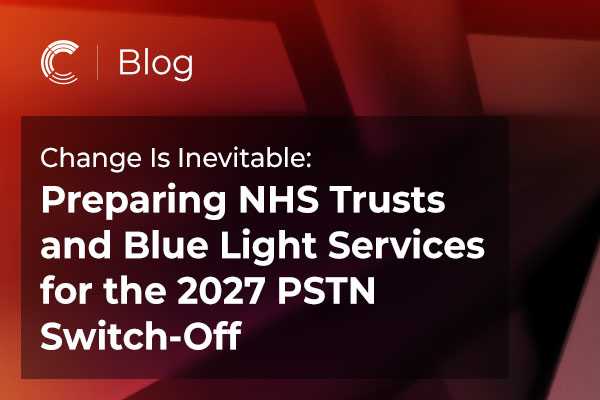
Act Early to Safeguard Critical Communications
April 16th, 2025
In recent years, the pace of change in communications has been nothing short of dramatic (COVID-19 I’m looking at you!). In response to the global pandemic, many organisations have accelerated their digital transformation strategies, not only to keep pace with an ever-evolving landscape but because change has become essential to staying connected and resilient.
One such transformation, already underway, is the BT Public Switched Telephone Network (PSTN) switch-off. Now scheduled to complete in 2027, this marks a vital but limited window for organisations to prepare.

BT PSTN Switch-Off Deadline Extended to January 2027
In April 2024, BT announced that the switch-off deadline would be extended to January 2027, in part to safeguard vulnerable users and ensure critical services like those used in healthcare are transitioned safely. While this new date offers more breathing room, it should not be seen as a reason to delay, particularly for organisations reliant on legacy systems for life-critical communications. Early preparation remains essential.

You can find more on how Cinos enables a smooth SIP migration in our earlier ISDN replacement blog by Jono Darlington.
PSTN Switch-Off Challenges for Critical Calling Services
Although this shift paves the way for improved digital connectivity, it also brings serious challenges for critical calling services. For organisations still reliant on legacy PSTN systems for their calls, any transition must be carefully managed, with risks thoughtfully mitigated. BT recognised this and extended the timeline primarily to support vulnerable users and organisations delivering life-critical services, acknowledging that more time is needed for safe and thorough migration away from legacy systems.
NHS Trusts & Blue Light PSTN Networks Affected
Prime examples here are NHS Trusts and Blue Light services, who stand at the forefront of maintaining public safety. The main concern for these services is the potential disruption to essential communication channels during emergencies, which could jeopardise public care and safety.
There is a general perception that sticking with legacy PSTN services, which have been used for decades, is a ‘risk averse’ strategy and that BT’s deadline extension makes inaction a safe choice. While moving the switch off to 2027 means the immediate problem has gone, it is only a temporary reprieve. The extended timeline provides organisations with a rare opportunity to approach migration proactively, with time to test, pilot, and implement robust solutions before legacy services are withdrawn completely.
Why move from your PSTN network before you have to? Understanding the benefits of SIP
Organisations who start planning their migration now will quickly start to realise the benefits of SIP above and beyond the PSTN services BT are phasing out. Cost is often seen as the main benefit, with cheaper calls, reduced line rentals fees, and reduced CAPEX and maintenance costs.
But for critical calling environments, the resiliency benefits are crucial to understand.
PSTN vs SIP
Traditional PSTN systems rely on physical lines running directly into your organisation. These fixed circuits are inherently inflexible and vulnerable to faults or disruptions. SIP, by contrast, uses IP-based technology — the same that powers internet services — enabling calls to be re-routed automatically in the event of connectivity issues. In practical terms, accidental damage to cables when workmen are digging up your street no longer has to mean complete phone service outages.
Responsibility and accountability are also key considerations. With PSTN services, it’s often unclear who takes ownership when problems arise — and delays in resolving issues can be costly. SIP, especially when delivered by a single, direct provider, removes much of this ambiguity. However, when SIP is resold by third parties, it can introduce unnecessary complexity at times when rapid resolution is critical.
Cinos are a Tier 1 SIP Service Provider
As a Tier 1 SIP Service Provider, Cinos offers our own SIP PSTN with no reliance on third parties. For our customers requiring a reliable platform for their calls, this means a single provider who can deliver a full end-to-end solution; from the red phone handset right the way to the PSTN. Cinos’ seasoned project teams specialise in coordinating with outgoing service providers to port/migrate numbers and number ranges efficiently.
In critical environments, the success of any new communications setup hinges on the expertise behind its implementation. A well-managed migration demands meticulous planning, precise execution, and resilient technology to reduce risk and avoid service disruption. When lives or public safety are at stake, even minor downtime can have serious consequences — making a well-planned and well-executed transition absolutely vital.
Demand for Skilled PSTN Network Migration Increasing
It’s also worth noting that as we move closer to the 2027 deadline, the demand for skilled migration support will increase, meaning early movers are likely to secure smoother transitions and better vendor support.
Cinos brings extensive experience in managing communications migrations for critical environments, supporting organisations such as Police Forces, Acute NHS Trusts, Hospitals, and Central Government departments. Put simply, we specialise in delivering critical SIP PSTN solutions for customers where uninterrupted voice services are essential — and in executing migrations with precision to minimise risk and downtime. This proven track record makes Cinos a trusted partner for healthcare providers and other critical services preparing for the PSTN switch-off in January 2027
Contact Cinos for SIP PSTN Services
The 2027 deadline may seem distant, but the time to act is now. By planning early, you reduce risk, secure support, and ensure your organisation is fully prepared. Contact Cinos now to begin shaping a future-proof communications environment well ahead of the 2027 deadline.




